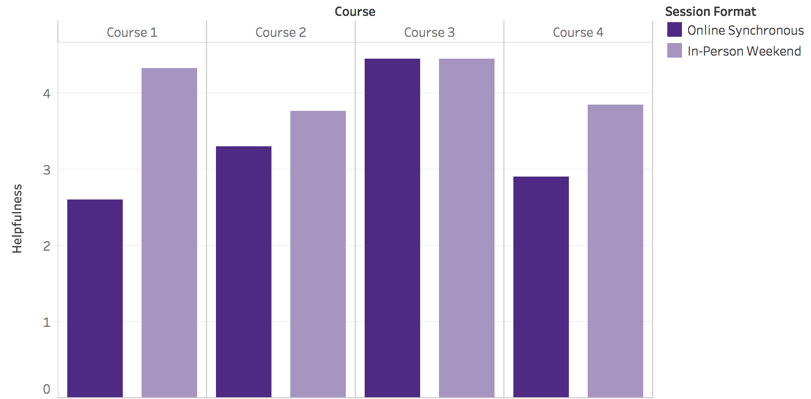Format
Blended learning, as opposed to fully online learning, was likely a strong contributing factor to establishing interpersonal connections and promoting ongoing engagement.In Brief
Classes include face-to-face weekend intensives and synchronous online sessions to help facilitate dialogue and build relationships, both with peers and instructors.
Instructional designers work closely with faculty to ensure that asynchronous content closely aligns with synchronous and face-to-face activities to create a cohesive learning experience.
The program works to ensure that our certificate (online) students have access to the same resources as our traditional (onsite) students, including academic and career counselors and professional development workshops. Students are encouraged to engage with the broader MSHE community via our online community and onsite social events.
Detail
In designing our blended certificate, we chose to use a combination of in-person and online synchronous class sessions supplemented by asynchronous content and activities. Based on research suggesting the importance of social presence in online learning (Zhan & Mei, 2012) and the value of blended over fully online environments (Bernard et al, 2014), we adopted this format to help facilitate interpersonal engagement – both between peers and between students and the instructor(s). Each class met for two in-person sessions, traditionally at the beginning and end of the quarter. Classes met for an additional 4-6 synchronous online sessions throughout the quarter, and students were expected to complete additional asynchronous work to prepare for or reflect on these sessions (Figure 1). All sessions were scheduled on the weekends (in-person) or evenings (synchronous online) to accommodate students’ work schedules and potential distance from campus.

Courses were adjusted partway through the year to reduce weekend hours and increase the number of online sessions in response to student feedback. While students and faculty reported some mixed feelings about the format as a whole, both reported high levels of satisfaction with weekend class sessions. Figure 2 shows students’ reported levels of helpfulness of the different course delivery formats.

Courses were approached with a structured design process, based on ADDIE which required faculty to work with instructional designers to determine the appropriate combination of in-person, synchronous, and asynchronous activities. This process offers some flexibility in structure so that the timing of the class sessions fit with the nature of the curriculum. Instructional designers emphasized alignment of learning activities (both synchronous and asynchronous) with the course objectives to create a cohesive experience across the different modalities, in which learning experiences build upon each other. For example, a course might include some lecture videos for students to watch on their own time, accompanied by an online quiz or reflection, followed by an in-class discussion exploring this same topic further. In one class (Course 3) an ongoing discussion board required students to connect class topics with current events. The instructor would identify particularly interesting or relevant posts to discuss further during the synchronous class sessions. Aligning activities as such provided students with multiple opportunities to engage with the material, both alone and collaboratively, and across a variety of formats, which might benefit different types of learners (see Activities & Tools for further discussion of this strategy).
The Higher Education and Administration program believes building a sense of community within the program can help promote relationships and engagement between students (and between faculty-students). In order to help facilitate this group dynamic, all certificate (blended format) students have access to the same program resources and events as traditional (in-person) students. Program staff, including academic and career counselors, are available to meet with students virtually or via phone when necessary and all workshops are either streamed live or converted into self-paced online modules. Program social events are scheduled to align with the in-person class sessions so certificate students can more easily attend. In addition, the program created an online community site, where students (both traditional and certificate) can access student resources and communicate via program-wide discussions (Figure 3). In addition to building deeper relationships for promoting in-class discussions, we believe fostering this sense of community will also increase program persistence, overall student satisfaction, and ongoing community engagement (including a robust alumni community).
